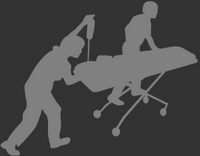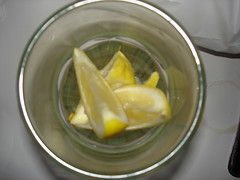 The homeless shelter's free clinic was slow that night. The doctors suggested that we practice doing blood draws on each other and I went inside the trailer to observe. A girl was doing inserting the needle into a docs arm.
The homeless shelter's free clinic was slow that night. The doctors suggested that we practice doing blood draws on each other and I went inside the trailer to observe. A girl was doing inserting the needle into a docs arm."Look away! You might feel a slight pinch!" she said, as if she were talking to a skittish patient instead of a hardened FP.
"Don't let go of the needle!" the doc said, commenting on her technique. "Hold it still so it won't slip out.
"Ok," she replied. Like a true ditz, she promptly let go of the needle to insert a vacutainer into the syringe-cover-looking thing.
"Uhm... you let go."
I laughed, a giddy nervousness spreading through my body. We're all inexperienced at these sorts of things. Even the third-year medical students aren't experts at blood draws; in the hospital, there is usually a nurse or a phlebotomist on hand to perform these routine (and for many, terrifying) procedures.
I had passed up the opportunity to attempt blood draws in the past. My preceptor at a small community clinic gave me the following advice about jumping in and attempting new procedures. "You will be an intern one day. For them, it is often see one, do one, teach one." Still, I chickened out on the big procedures. A small girl enthusiastically asked for a blood pressure reading one time. I attempted to read her BP and made her wince in pain as I pumped the cuff. "Whoops. Too much. I don't know what I'm doing..." I said lamely.
I quelled my nervous energy as the girl finished up, attempting to be professional despite the minor mistakes she made along the way. "Apply pressure on this gauze for two minutes and you should be fine!"
A family medicine resident came in and surveyed the crowd. "I'm donating my left arm to whoever whats to try the next blood draw!" Suddenly, computer screens, pill bottles, and posters on the wall became the subjects of great scrunity. The only one who held her gaze was me. The other students shuffled back a few steps.
The resident seemed surprised by the response. "Doesn't anyone else want to practice?"
I steeled my resolve. I'm a MED student now, danggit! I gotta be willing to just jump into things and give them a go. "I'll try! This is only my second day of medical school though, so you'll have to talk me through it."
The resident smiled at me and said "Sure. Let me get all of the supplies set up for you." We retrieved some gloves, a small vacutainer, a needle-tube-needle, a rubber tourniquet, a few alcohol swabs, some gauze, tape and that barrel-syringe-cover-looking thing. Sorry, my terminology is not up to par. We spent a few minutes talking over the procedure and setting everything up so it was accessible and ready before I did anything with the sharps.
I learned a few tips that I would not have picked up just from observation.
Following the set-up, the rubber tourniquet is tied around the upper arm with a tucked loop. A simple pull on one end undoes the knot after the blood draw is complete. A tourniquet should be applied for no more than three minutes -- after that, the arm will begin to get the "pins and needles" sensation.
The subject pumps their hand a few times to raise the vein up. Tap along the vein to get a feel of where it is. Clean it with an alcohol swab, with a spiraling circle motion outwards from the point of entry. Hyper-extend the patient's elbow to raise the vein and firmly place your thumb on their lower arm on the vein. This will prevent the vein from rolling away from the needle.
Insert the needle bevel up (the hole angled towards you) along the vein at ~30 degree angle -- "scoop" a bit when you hit the vein so you don't puncture through the opposite wall. A flash of blood will reward you for your efforts!
Move your thumb off the vein onto the needle to secure it safely in the vein. Don't let it shift or slip. Bruising, pain or bleeding can result!
Take your other hand and insert whatever color vacutainers you need for the procedure into the barrel of the syringe-thingie. Blood should flow in by the vacuum. Don't let it get too full. Remove the vacutainer and replace with the next. Before you remove the last container, loosen the tourniquet. Remove the vacutainer before removing the needle. The FP doc told us of horror stories from his first blood draw with frothing, bubbling blood spraying out all over the place.
Fold a piece of gauze in half and place it gently on the site of injection. Don't push down hard. Pull out the needle gently and apply pressure. Have the subject fold their arm or apply pressure with their other hand while you get the band-aid/paper tape ready. Put the bandage on and you're done!
A few extra tips: used sharps go in the sharps container. Never place them down anywhere else. Communicate with the patient -- this will put them at ease and help you review what else you need to do.
Another first-year with whom I was tagging around with at the homeless shelter was emboldened by my success. For the rest of the night, the FP resident was walking around showing her bandaged arms to everyone she met.
"Two first-years drew my blood tonight," she bragged. "They both got it in on their first try for their first time!!"
It was a good feeling. :)
Here's a link on venipuncture for those of you who want to learn more.





